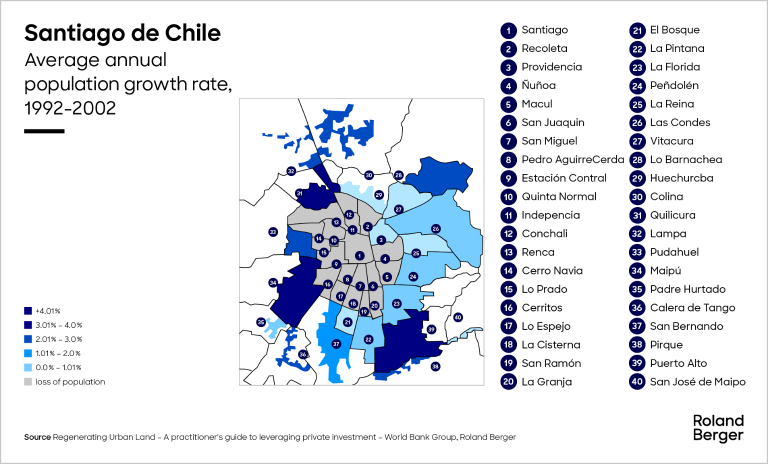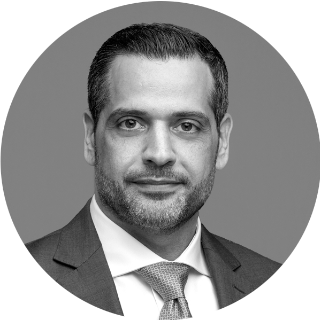Roland Berger works with public, private and non-governmental clients in meeting the major challenges within our society. Contact us now.


Combating urban decay
By Bilal Rammal
Causes of decline and strategic imperatives for successful urban regeneration
The wellbeing of communities is reflected in the vitality of their districts and neighborhoods. These areas act as key spaces for social and economic interaction, shaping daily life by providing housing, employment opportunities and essential services – from education, retail and cultural activities to entertainment. Beyond their practical functions, districts also play a crucial role in fostering social connections, strengthening local networks and reinforcing a shared sense of identity and belonging among residents. When properly maintained, they not only enhance social cohesion but also create a fertile environment for economic growth and community resilience.

Yet, urban decay appears to be a universal phenomenon. Often, the decline sets in gradually. Identifying early warning signs is a crucial basis for timely action by planners and policymakers to prevent further deterioration.
In this article we examine key factors contributing to urban decay, including demographic shifts – such as population growth or decline – and fluctuations in the real estate market, particularly changes in property values and rental prices. We also provide insights into early detection and outline strategic priorities for interventions by government and local authorities to sustain urban vitality.
Early warning signs
Shifts in population size often serve as an early warning sign of urban decline. In some cases, residents relocate to nearby areas in search of better services, economic opportunities and improved quality of life, leading to population loss and reduced density in the original district. In other instances, urban sprawl – characterized by the unchecked expansion of development into surrounding areas – drives residents away from inner districts, accelerating their decline. These population shifts can weaken local economies, diminish social cohesion and accelerate the deterioration of urban infrastructure.
To take an example, urban decline in central neighborhoods in the City of Santiago, Chile, was foreshadowed by a significant residential shift that began in the late 1990s. During this period, the steady migration of residents from the city center to peripheral districts led to a dramatic population decrease in central areas, while the population of the Metropolitan Region continued to grow strongly – as it had since the 1950s. Over time, this movement resulted in a 50% decline in the number of inhabitants in the central areas, contributing to their gradual deterioration.


Falling demand for housing on the real estate market is another sign of the onset of deterioration. As population numbers dwindle, demand for housing decreases, triggering a downward spiral of plummeting real estate prices, depreciating property values and a rising number of vacant homes. This cycle further accelerates urban decline, reducing investment incentives and weakening the overall economic stability of affected districts.
Beyond population numbers, the social fabric of a district plays a crucial role in its stability and economic viability. Shifts in the economic, ethnic or cultural makeup of residents can influence property values and also serve as early indicators of urban decline. For example, in Doha's Old Al Ghanim area, the departure of the prominent Alghanim merchant family led to an influx of foreign workers, triggering a decline in housing prices. Similarly, Johannesburg in South Africa experienced a transformation following the end of apartheid in 1991. With greater freedom of movement, the city saw a redistribution of its population – wealthier white residents relocated to the northern suburbs, while low-income black residents moved from the townships into the city center. This demographic shift altered investment patterns, leading to disinvestment in central areas. Property owners, responding to new market dynamics, began renting buildings to low-income tenants, further driving down rental prices. Such cases highlight how urban decay is often intertwined with changes in the social fabric, influencing property markets and shaping the long-term trajectory of city districts.
Fundamental factors
While shifts in demographics and fluctuations in the real estate market are often the outward signs of incipient urban decline, the phenomenon as a whole is driven by several deeper, interconnected factors. One of these key factors is underlying socio-economic shifts. Economic conditions can shift dramatically, driven by factors such as deindustrialization or the relocation of key industries and business activities away from urban centers. Cyclical events such as recessions can also significantly affect neighborhoods and districts.
A good example is Bilbao, Spain, in the 1980s, which experienced a severe economic downturn due to the oil crisis. This led to a sharp decline in the heavy manufacturing sector, resulting in an unemployment rate of more than 25%. The effects of this economic collapse rippled beyond the job market, influencing urban planning and reshaping the metropolitan landscape. Large industrial zones were left abandoned, and inefficient land use practices became widespread.
The case of Bilbao highlights another key factor in urban deterioration: the lack of effective planning and government oversight. In Bilbao, poor urban planning decisions from the 1960s led to chaotic land reductions, leaving large areas of undeveloped land near urban zones. Similarly, in Johannesburg, following the end of apartheid, there was no effort to reorganize the spatial planning, which resulted in investments shifting to the suburbs and the continued decline of the city center. Urban blight can also be driven by deficiencies in infrastructure and services, including the deterioration of public spaces and inadequate public services.
The power of positive action
Case study: Old Al Ghanim district, Doha, Qatar
The Old Al Ghanim district in Doha, Qatar, is one of the city's oldest neighborhoods, characterized by its rich history and traditional architecture. However, over the years, the area has experienced significant changes due to rapid urban development. This has led to challenges such as deteriorating infrastructure and displacement of the original residents.
In response, a number of regeneration efforts have been initiated to revitalize the district, aiming to preserve its cultural heritage while improving living conditions and infrastructure. Key aspects include:
Improving infrastructure: Upgrading roads, utilities and public transit to enhance connectivity and accessibility
Engaging the community: Involving local residents in the planning process to ensure the redevelopment meets their needs and preserves the area's social fabric
Sustainable development: Implementing environmentally friendly practices to create a sustainable urban environment
Case study: Central Riyadh, Riyadh, KSA
Riyadh has seen extensive urban development since the early 1930s, transforming it from a compact desert settlement into a sprawling metropolitan hub. Since 2010, the city's population has grown by more than two million, an average annual growth rate of 2.5%. Growth is predominantly concentrated in the northern corridors, which account for more than 60% of new developments, driven by large-scale infrastructure investments, high-end residential projects and commercial expansion.

This rapid expansion has led to spatial imbalances, particularly affecting Riyadh's central districts, such as Al Malaz, Al Badi'a, Al Rafi'a, Al Murabba' and Ulaisha. These historically significant areas, once prime residential zones, have seen a steady outflow of Saudi residents, leading to demographic shifts, declining property values and underutilization of key urban assets.
Local authorities have responded proactively to the challenges of urban decline by launching district regeneration programs aimed at revitalizing Riyadh's historic and underutilized areas. These interventions aim to reverse urban decline, stimulate economic activity and position Riyadh's central districts as competitive, high-value urban destinations. The authorities have taken a multifaceted approach to urban renewal, including:
Conserving heritage and adapting it for new uses: Restoring historically significant buildings and sites, and integrating cultural landmarks into mixed-use developments to preserve Riyadh’s architectural identity while improving economic viability
Enhancing infrastructure and mobility: Investing in transportation networks – including metro and bus rapid transit (BRT), improved road connectivity and smart mobility solutions – to increase accessibility and reduce congestion in regenerated districts
Expanding public areas and green spaces: Developing open spaces, landscaped parks and pedestrian pathways to improve livability, promote social interaction and increase property values in regenerated neighborhoods
Incentivizing private-sector participation: Implementing regulatory and financial incentives such as tax breaks, public-private partnerships (PPPs) and streamlined permitting processes to attract investment and accelerate redevelopment efforts
Engaging the community and ensuring socioeconomic inclusion: Running programs involving local residents and businesses in the regeneration process, ensuring that redevelopment projects align with community needs and promote inclusive growth
Strategic imperatives for action
Ensuring the health and vibrancy of districts and neighborhoods – the lifeblood of a nation's social fabric – is crucial for enabling social cohesion and promoting economic growth. Governments should sit at the helm of district regeneration efforts, overseeing action to combat urban decay and drive economic and social revitalization in struggling neighborhoods.
We recommend that governments, through national and local authorities, set themselves the following priorities with regard to urban regeneration:
A clear vision for the district: Successful district regeneration begins with a well-defined vision that guides the development of a comprehensive spatial plan. Government interventions are most effective when driven by a clear goal, focused on economic revitalization, social improvement and environmental sustainability
Cultural preservation and identity: Regeneration projects should prioritize preserving the unique cultural and historical characteristics of neighborhoods. Strong place-making strategies and the creation of distinct urban identities are essential for attracting both investment and foot traffic, ensuring the district's appeal
Incentive schemes: Public intervention alone is not enough; it must be complemented by private-sector involvement. Private investment often comes in the later stages, drawn by available opportunities. To create an environment conducive to private sector participation, governments can consider offering incentives such as tax breaks, public-private partnerships, loans and grants
Catalytic areas and horizontal interventions: Regeneration is typically executed on two levels: targeted (catalytic) interventions in key areas, and broader horizontal initiatives that affect the entire district. Catalytic projects serve as a demonstration of potential, showcasing the area's viability for private investment; horizontal interventions work to enhance the district as a whole, increasing its value and improving quality of life for residents
Community engagement and empowerment: Effective regeneration relies on an inclusive planning process that actively involves local communities, businesses and other stakeholders. Transparency, participation and capacity-building are vital to ensure that the benefits of regeneration are shared equitably among all residents
Affordable, inclusive housing: Gentrification and displacement are significant risks in any regeneration project. We recommend that governments implement policies safeguarding affordable housing options and protecting vulnerable populations, such as inclusionary zoning and community land trusts – preventing the marginalization of local residents
In conclusion, the key to combating urban decay is an understanding of its root causes and an ability to spot the early warning signs. Action should be based on a clear vision, a commitment to preserving cultural identity and – vitally – the inclusion of local stakeholders, supported by an environment that encourages participation by private players. By acting simultaneously on all these fronts, governments can effectively combat the onset of urban decline, and in so doing preserve the lifeblood of the nation.
Interested in finding out more? Contact Roland Berger.






